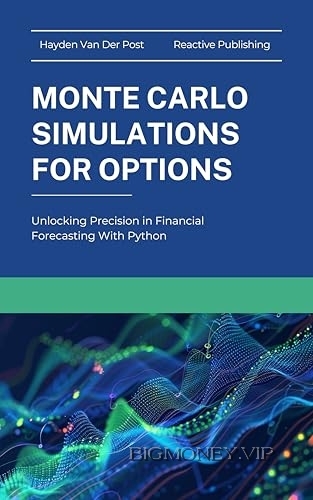Monte Carlo Simulations for Options: Unlocking Precision in Financial Forecasting with Python by Hayden Van Der Post

CHAPTER 1:
INTRODUCTION TO
MONTE CARLO
SIMULATION
Monte Carlo simulation, a term that conjures images of high-stakes
gambling and strategic risk-taking, is an apt title for a method that
thrives on randomness and probability. Named after the famous
Monte Carlo Casino in Monaco, where chance and calculation intertwine,
this mathematical technique harnesses randomness to solve problems that
might be deterministic in nature.
Imagine standing at the bustling plaza outside the Monte Carlo Casino, the
heart of world-class glamour and high-rolling excitement. Amidst the
opulent backdrop, envision a roulette wheel spinning, each number
representing a potential outcome. This vivid imagery captures the spirit of
Monte Carlo methods—strategically using random sampling to explore the
vast landscape of possibilities in complex problem-solving.
Monte Carlo simulations are, at their core, a way to understand and predict
the behavior of systems influenced by uncertainty. In finance, this translates
to modeling the future movements of stock prices, interest rates, and other
variables that are inherently unpredictable. Let’s delve into this powerful
technique that transforms chaos into structured predictions.
Origin and Historical Context
The origins of Monte Carlo simulations trace back to the days of World War
II. The mathematician John von Neumann, along with Stanislaw Ulam and
Nicholas Metropolis, initially developed these techniques. They were
working on the Manhattan Project, seeking ways to model neutron diffusion
in nuclear reactions. Ulam, inspired by his own card game experiences
during recovery from illness, saw the potential of using stochastic processes
to solve deterministic problems. The name "Monte Carlo" was coined as an
homage to the chance-filled nature of the famous casino.
Over the decades, Monte Carlo methods have evolved and expanded
beyond their military roots. They now serve various fields, from
astrophysics to biology. In finance, Monte Carlo simulations became
particularly crucial as markets grew more complex and interconnected.
They enable analysts to model financial systems that are too intricate for
traditional deterministic models.
How Monte Carlo Simulations Work
Imagine trying to predict the future price of a stock. Traditional models may
provide a single-point estimate based on historical data and assumed
volatility. Monte Carlo simulations, however, approach the problem
differently. They generate a multitude of possible future paths for the stock
price by randomly sampling from the probability distribution of returns.
Each path represents a possible future scenario.
To illustrate, picture yourself at a crossroads in New York City, where taxis
are continuously navigating the grid. Each taxi’s journey is unpredictable; it
may take any number of routes to its destination. Monte Carlo simulations
mimic these taxi journeys, repeatedly sampling different routes to capture
the range of possible outcomes. They offer a richer, more comprehensive
understanding of potential futures compared to a single deterministic
forecast.
Basic Principles: Random Variables and Probabilities
At the heart of Monte Carlo simulations lie random variables and their
associated probabilities. A random variable is a numerical outcome derived
from a random process, such as the roll of a die. Each possible outcome has
a probability, a measure of the likelihood of its occurrence.




